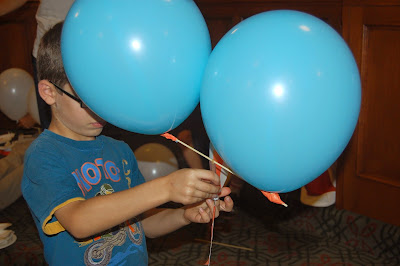Great books about space and the planets
I was doing some work on the nonfiction collection today, focusing on the shelves about astronomy, space, planets and time. While examining the books closely, I came across a few that I want to remember as being really interesting:
Faraway Worlds: Planets Beyond Our Solar System, by Paul Halpern and Illustrated by Lynette R. Cook, is a fascinating look at the search for distant planets. It contains simple visual demonstrations of how scientists are able to find stars that have planets--the "wobbling star" is explained with a good diagram about the gravitational pull of a large planet. Halpern's writing is very accessible and Cook's illustrations take the book to another level of imaginative wonder, as she artfully speculates what a beach might look like on a planet with two suns. There is even a page at the end dedicated to explaining how Cook comes up with her illustrations. Really a fantastic and imaginative read.
I found a lot of books about the Hubble Telescope for all different levels of readers, but none so beautiful as Space, Stars and the Beginning of Time: What The Hubble Telescope Saw by Elaine Scott. It's not just the phenomenal, crisp Hubble Space Telescope photos of nebulas and novas that sets this one apart from our other books on the subject. It's a very well-written book about everything that the Hubble's images have taught us about the nature of our universe and how it was formed. Scott deftly covers different types of stars and their life cycles, the evolution of galaxies and the functions of black holes. She also covers the history of the Hubble, and the heroic challenge undertaken to fix what is truly "one of the greatest scientific instruments of all time" (p. 4). But what the Hubble has to teach us about the history of the universe is this book's real achievement. Scott demonstrates how the Hubble has lead us to the knowledge that:
- the universe is 13.7 billion years old
- dark matter makes up most of the material in the universe
- there are lots of other solar systems like ours
and a lot more. Some of the reading might be dense for a child, but for the most part it is very accessible and well-done.
Finally, I was thinking about discarding this one, but couldn't part with it after discovering how good it is. How We Learned the Earth is Round, by Patricia Lauber and illustrated by Megan Lloyd, is probably one of the best, most on-point explanations I've seen regarding this very important human achievement. Lloyd's illustrations are very kid-friendly, perfect for Lauber's excellent and kid-friendly prose. Lauber lays out the whole history of human thought about the world in a way that a second-grader could easily grasp. I don't want to weed this book! I want to put it in the hands of a child and say, "Read this so you know how the ancient Greeks knew so much about our planet, thousands of years before satellite telescopes were invented!" It's a great introduction to science and the courage it takes to explore the full range of possibilities suggested by one's careful observations of the world.




Comments
Post a Comment